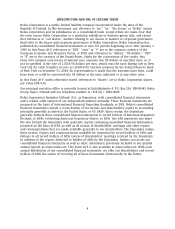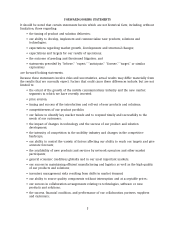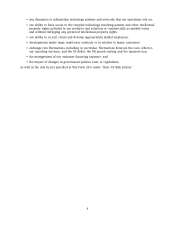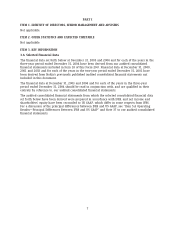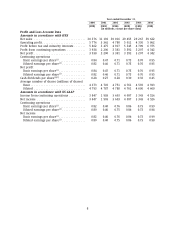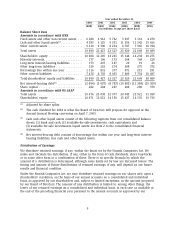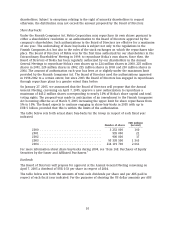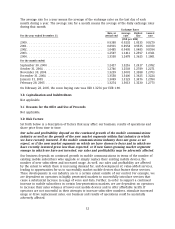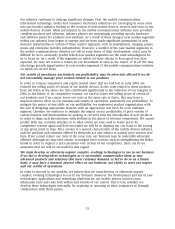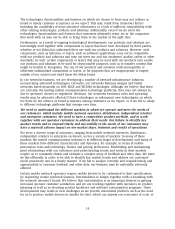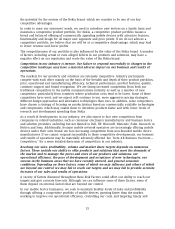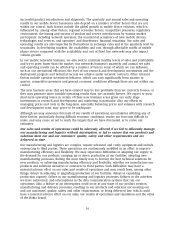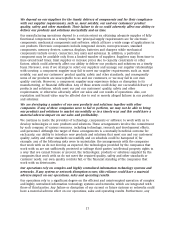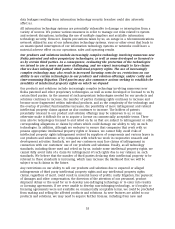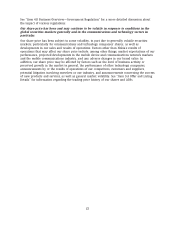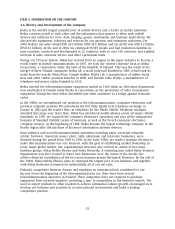Nokia 2004 Annual Report Download - page 14
Download and view the complete annual report
Please find page 14 of the 2004 Nokia annual report below. You can navigate through the pages in the report by either clicking on the pages listed below, or by using the keyword search tool below to find specific information within the annual report.Our industry continues to undergo significant changes. First, the mobile communications,
information technology, media and consumer electronics industries are converging in some areas
into one broader industry leading to the creation of new mobile devices, services and ways to use
mobile devices. Second, while participants in the mobile communications industry once provided
complete products and solutions, industry players are increasingly providing specific hardware
and software layers for products and solutions. As a result of these changes, new market segments
within our industry have begun to emerge and we have made significant investments in new
business opportunities in certain of these market segments, such as smartphones, imaging, games,
music and enterprise mobility infrastructure. However, a number of the new market segments in
the mobile communications industry are still in early states of their development, and it may be
difficult for us to accurately predict which new market segments are the most advantageous for
us to focus on. As a result, if the segments on which we have chosen to focus grow less than
expected, we may not receive a return on our investment as soon as we expect, or at all. We may
also forego growth opportunities in new market segments of the mobile communications industry
on which we do not focus.
Our results of operations, particularly our profitability, may be adversely affected if we do
not successfully manage price erosion related to our products.
In order to remain competitive and regain market share that we had lost in early 2004, we
reduced the selling prices of certain of our mobile devices. As the costs related to these products
have not fallen at the same rate, this contributed significantly to the reduction of our margins in
2004. In the future, if, for competitive reasons, we need to lower the selling prices of certain of
our products and if we cannot lower our costs at the same rate or faster, this may have a
material adverse effect on our business and results of operations, particularly our profitability. To
mitigate the impact of mix shifts on our profitability, we implement product segmentation with
the aim of designing appropriate features with an appropriate cost basis for each customer
segment. Likewise, we endeavor to mitigate the impact on our profitability of price erosion of
certain features and functionalities by seeking to correctly time the introduction of new products,
in order to align such introductions with declines in the prices of relevant components. We cannot
predict with any certainty whether or to what extent we may need to lower prices for
competitive reasons again and how successful we will be in aligning our cost basis to the pricing
at any given point in time. Price erosion is a normal characteristic of the mobile devices industry,
and the products and solutions offered by Networks are also subject to natural price erosion over
time. If we cannot reduce our costs at the same rate, our business may be materially adversely
affected. Although we may take actions to mitigate price erosion, such as strengthening the Nokia
brand in order to support a price premium over certain of our competitors, there can be no
assurance that we will be successful in this regard.
We must develop or otherwise acquire complex, evolving technologies to use in our business.
If we fail to develop these technologies or to successfully commercialize them as new
advanced products and solutions that meet customer demand, or fail to do so on a timely
basis, it may have a material adverse effect on our business, our ability to meet our targets
and our results of operations.
In order to succeed in our markets, we believe that we must develop or otherwise acquire
complex, evolving technologies to use in our business. However, the development and use of new
technologies, applications and technology platforms for our mobile devices involves time,
substantial costs and risks both within and outside of our control. This is true whether we
develop these technologies internally, by acquiring or investing in other companies or through
collaboration with third parties.
13



